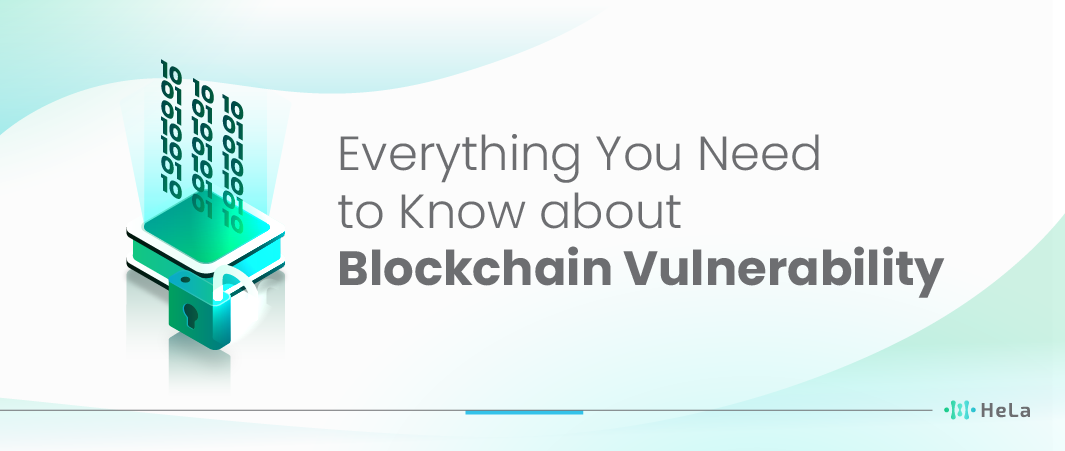Blockchain technology has transformed numerous industries by introducing transparency, security, and decentralization. However, even though blockchain boasts a robust design, it is not impervious to vulnerabilities. In this article, we’ll take a closer look at the realm of blockchain vulnerability, shedding light on the primary threats it encounters and offering practical guidance on how to evaluate and minimize these risks.
Blockchain vulnerability is a topic of increasing concern in the digital age. Despite its promise, blockchain systems can still be vulnerable to a range of security issues, such as hacking attempts, smart contract vulnerabilities, and consensus protocol weaknesses. To effectively safeguard blockchain networks, it is crucial to understand these potential threats and implement proactive measures to mitigate them.
To address blockchain vulnerability, organizations and individuals alike must adopt a comprehensive approach. This includes conducting regular security audits, staying updated on the latest blockchain security best practices, and fostering a culture of cybersecurity awareness. By taking these steps, we can harness the full potential of blockchain technology while minimizing the inherent risks it may pose.
Understanding Blockchain Vulnerability
Blockchain vulnerability encompasses the possible weaknesses or imperfections in blockchain networks that malicious entities might exploit. Despite blockchain technology’s renowned security attributes, it’s important to recognize that no system is completely impervious. Understanding the specifics of these vulnerabilities is crucial in effectively protecting digital assets.
This understanding involves acknowledging that blockchains, while resilient, are not immune to a range of potential threats, such as 51% attacks, code vulnerabilities, consensus failures, or smart contract flaws. These vulnerabilities can lead to various issues, including theft of digital assets, data manipulation, and loss of trust in the system. Therefore, constant vigilance, updating security protocols, and understanding the evolving landscape of blockchain threats are essential for maintaining the integrity and security of blockchain systems.
Common Blockchain Vulnerabilities
To address blockchain vulnerabilities effectively, it’s crucial to recognize the common threats that can compromise the security and integrity of a blockchain network. Blockchain technology has gained widespread adoption in various industries due to its inherent security features, but it is not immune to risks. Here are some of the most prevalent threats and vulnerabilities that blockchain networks may face:
51% Attacks
In a Proof of Work (PoW) blockchain, a 51% attack occurs when a single entity or group controls over 50% of the network’s mining power. This enables them to manipulate the blockchain, double-spend cryptocurrencies, and potentially disrupt the network’s consensus.
Sybil Attacks
Sybil attacks involve an attacker creating multiple fake identities or nodes on the network to gain control or influence over the consensus process. This can lead to the centralization of the blockchain, undermining its decentralization principles.
Also Read: Metaverse Wallet Explained: Virtual Currency and Real Potential
Smart Contract Vulnerabilities
Smart contracts are self-executing code on the blockchain, and they can contain vulnerabilities that can be exploited by attackers. Common issues include reentrancy attacks, integer overflow/underflow, and improper access control.
Consensus Protocol Flaws
The consensus mechanism used by a blockchain, whether PoW, Proof of Stake (PoS), or others, can have vulnerabilities. For example, PoS networks may be susceptible to long-range attacks or nothing-at-stake attacks.
Double Spending
While blockchains are designed to prevent double spending, some cryptocurrencies, especially in private or permissioned networks, may be vulnerable if not properly configured or maintained.
Privacy Concerns
Public blockchains, like Bitcoin and Ethereum, are transparent by design. However, this transparency can become a vulnerability when sensitive transaction information is exposed. Privacy coins and techniques like zero-knowledge proofs aim to address this issue.
Quantum Computing Threats
The advent of quantum computing poses a potential threat to blockchain security, as it could potentially break the cryptographic algorithms used in existing blockchains. This has led to research into post-quantum cryptography and quantum-resistant blockchain solutions.
Software Bugs and Updates
Like any software, blockchain implementations can contain bugs and vulnerabilities that hackers can exploit. Regular software updates and audits are essential to patching these vulnerabilities.
DDoS Attacks
Distributed Denial of Service (DDoS) attacks can overwhelm a blockchain network with traffic, causing disruption or slowdowns in transaction processing and validation.
Social Engineering and Phishing
Human error remains a significant threat, as attackers may use social engineering or phishing techniques to trick users into revealing their private keys or other sensitive information.
Inadequate Governance
Governance issues within blockchain communities can lead to disputes, hard forks, and a lack of consensus, potentially weakening the overall security and trust in the network.
Centralized Points of Failure
Some blockchain networks may rely on centralized components, such as centralized oracles in DeFi applications, which can become single points of failure if compromised.
Understanding these common blockchain vulnerabilities is essential for developers, users, and organizations involved in blockchain technology. Proactive measures, ongoing security assessments, and community cooperation are key to mitigating these threats and ensuring the long-term security of blockchain networks.
Assessing Blockchain Vulnerability

Assessing blockchain vulnerability is a critical aspect of maintaining the security and integrity of blockchain systems. Consider the following steps:
1. Regular Audits
- Purpose: Identify potential security weaknesses in code and smart contracts.
- Process: Involves the systematic review of the codebase and smart contracts by experts.
- Outcome: Detects bugs, poor coding practices, and areas prone to attacks.
2. Penetration Testing
- Purpose: Simulate cyber-attacks to test the defense mechanisms of blockchain networks.
- Process: Professional ethical hackers attempt to breach the system using various attack vectors.
- Outcome: Reveals the blockchain’s resilience to real-world attacks and highlights areas for improvement.
3. Security Best Practices
- Purpose: Establish a secure operating environment for blockchain operations.
- Process: Implementing measures like access controls to limit who can interact with the blockchain, and data encryption to secure information stored on the blockchain.
- Outcome: Reduces the risk of unauthorized access and data breaches, enhancing overall system security.
Each of these steps plays a crucial role in ensuring that a blockchain network remains secure against evolving threats. Regularly updating security protocols and staying informed about new vulnerabilities are also important parts of maintaining blockchain security.
Mitigating Blockchain Vulnerability

Mitigating blockchain vulnerability is of paramount importance in ensuring the integrity and security of a blockchain network. Taking a proactive approach to enhance security is essential to protect against potential threats and vulnerabilities. Here are some strategies to enhance security:
Consensus Protocol Upgrades
Staying informed about the latest blockchain technology developments is crucial. Consider upgrading to more secure consensus mechanisms like Proof of Stake (PoS) or Delegated Proof of Stake (DPoS) to enhance network security.
Bug Bounties
Encourage security researchers to find and report vulnerabilities in your blockchain network through bug bounties. This approach attracts expert scrutiny, uncovering hidden issues and demonstrating your commitment to security transparency.
Regular Updates
Keeping your blockchain software up to date is vital. Regular updates from developers include security patches, bug fixes, and improvements. Apply these updates promptly to reduce the risk of known vulnerabilities and secure your network.
Multi-Layered Security
Implement a multi-layered security approach to protect your blockchain network. This includes not only securing the underlying blockchain technology but also the surrounding infrastructure, including nodes, wallets, and communication channels.
Smart Contract Audits
Smart contracts are an integral part of many blockchain applications. Conduct regular smart contract audits to identify and fix vulnerabilities in the code. Engage with third-party auditing firms or security experts to perform these audits.
Penetration Testing
Regularly perform penetration testing on your blockchain network to identify weak points and vulnerabilities. This helps in discovering potential security flaws that may not be apparent through traditional testing methods.
Network Monitoring
Implement real-time network monitoring and anomaly detection systems to detect suspicious activities and potential security breaches promptly. Monitoring tools can help in identifying and mitigating threats before they escalate.
Permissioned Blockchains
Consider using permissioned or private blockchains for sensitive applications. These blockchains restrict access to a predefined group of participants, reducing the attack surface and enhancing security.
Secure Key Management
Effective key management is critical for blockchain security. Employ hardware security modules (HSMs) or other secure key storage solutions to protect private keys from theft or unauthorized access.
Security Training
Ensure that all personnel involved in blockchain development and maintenance receive adequate security training. Human error is a common source of vulnerabilities, so educating your team can help prevent security lapses.
Immutable Ledger Backup
Regularly back up the immutable ledger data to ensure data integrity. Securely store backups offline to protect against data loss due to cyberattacks or hardware failures.
Zero-Day Vulnerability Response
Have a well-defined response plan in place for zero-day vulnerabilities. This includes procedures for quickly patching or mitigating vulnerabilities as soon as they are discovered.
Collaborate with the Blockchain Community

Engage with the broader blockchain community to share insights and best practices for security. Collaborating with peers and experts can help you stay ahead of emerging threats.
Regulatory Compliance
Stay informed about relevant regulatory requirements for your blockchain application, especially in sectors with strict compliance standards (e.g., finance, healthcare). Ensure that your blockchain implementation aligns with these regulations.
Incident Response Plan
Develop a comprehensive incident response plan that outlines the steps to take in case of a security breach. This plan should include communication protocols, forensics procedures, and legal considerations.
Mitigating blockchain vulnerability is an ongoing process that requires a combination of proactive measures, continuous monitoring, and a commitment to staying up-to-date with the latest security trends and technologies. By implementing these strategies, blockchain networks can better protect themselves against potential threats and vulnerabilities.
Collaborative Efforts for Blockchain Security
In the rapidly evolving landscape of blockchain technology, ensuring the security of blockchain networks has become paramount. Blockchain, as a decentralized and distributed ledger, is designed to be transparent and tamper-resistant. However, it is not immune to vulnerabilities and threats. That’s where collaborative efforts within the blockchain community come into play.
The blockchain community, which comprises developers, miners, users, and various stakeholders, plays a pivotal role in addressing and mitigating vulnerabilities within the blockchain ecosystem. This collective effort is essential for maintaining the integrity and trustworthiness of blockchain networks.
One of the key aspects of collaborative security efforts in the blockchain space is open communication channels. Developers, the driving force behind blockchain projects, need to work closely with one another to identify and rectify vulnerabilities in the underlying code. They should also engage in open dialogue with the broader community to gather insights and suggestions for improving security.
Miners, who validate transactions and secure the network through consensus mechanisms, are another crucial part of this ecosystem. Their active participation in maintaining network security is vital. Miners should continuously update their software and adhere to best practices to prevent potential threats like 51% attacks.
Also Read: What Is Stack Mobile? A Step-by-Step Introduction
Users, including individuals, businesses, and organizations, are the end beneficiaries of blockchain technology. They can contribute to security efforts by adopting best security practices, such as safeguarding private keys and wallets, and staying informed about potential threats. Additionally, reporting any suspicious activities or vulnerabilities they encounter is essential for the community’s collective security.
Furthermore, sharing security-related information within the blockchain community is essential for staying vigilant against emerging threats. Vulnerabilities and attack vectors are constantly evolving, and a unified front is necessary to combat them effectively. By openly sharing information about security incidents, potential vulnerabilities, and successful defense strategies, the community can better prepare itself for future challenges.
Conclusion
In conclusion, as we continue to explore the constantly changing world of blockchain technology, it’s vital for developers, businesses, and regulators to work together and share their knowledge. This collaborative effort is necessary to strengthen the security of blockchain networks, especially in light of the persistent blockchain vulnerability issues that can arise. We must stay alert and adapt to these emerging threats, always striving to stay ahead in the ongoing battle to safeguard the reliability and trustworthiness of blockchain systems. By taking these steps, we can fully harness the potential of blockchain technology, transforming various industries, increasing transparency, and providing individuals with the assurance that their digital assets are kept safe and sound.
To put it simply, teamwork and vigilance are the keys to maintaining blockchain security. By fostering a spirit of cooperation and staying informed about the latest blockchain vulnerability concerns, we can make significant strides in ensuring the protection and stability of blockchain networks. This, in turn, paves the way for blockchain technology to revolutionize different sectors, bringing about greater transparency and instilling confidence in users that their digital assets are well-protected.
Disclaimer: The information provided by HeLa Labs in this article is intended for general informational purposes and does not reflect the company’s opinion. It is not intended as investment advice or recommendations. Readers are strongly advised to conduct their own thorough research and consult with a qualified financial advisor before making any financial decisions.

Joshua Soriano
I am a writer specializing in decentralized systems, digital assets, and Web3 innovation. I develop research-driven explainers, case studies, and thought leadership that connect blockchain infrastructure, smart contract design, and tokenization models to real-world outcomes.
My work focuses on translating complex technical concepts into clear, actionable narratives for builders, businesses, and investors, highlighting transparency, security, and operational efficiency. Each piece blends primary-source research, protocol documentation, and practitioner insights to surface what matters for adoption and risk reduction, helping teams make informed decisions with precise, accessible content.
- Joshua Soriano#molongui-disabled-link
- Joshua Soriano#molongui-disabled-link
- Joshua Soriano#molongui-disabled-link
- Joshua Soriano#molongui-disabled-link

